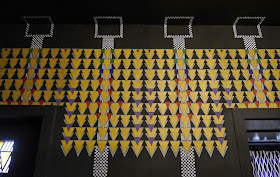The Guildhall
Northampton is the second largest town in England (after Reading) and seemed a worthy target for an outing on the first dryish day for a while. I followed the Northampton Heritage Trail available on the Borough Council's website.
The walk starts at the Church of the Holy Sepulchre (1103), the oldest church in the town and one of only four surviving round churches in the country. The tower was added in the 15th century and the church was further enlarged in the 1860s.
These churches were built by returning Crusaders on the model of the Holy Sepulchre church in Jerusalem. The others are: Temple in London, the Round Church (correctly also Church of the Holy Sepulchre) in Cambridge and St John the Baptist, Little Maplestead, Essex. Having now seen three, I can feel a trip to Essex coming on.
Now you walk down to the very large Market Place, where the market was in full swing. My eye was drawn to this house in a quiet corner. It is the Welsh House, which dates from 1595 and survived the great fire of 1675. The facade was recreated in 1975 when the adjoining Grosvenor Centre was built.
At the bottom the Market Square I turned into pedestrianised Abington St which had a wide variety of building types including this rather wonderful art deco one.
And at the top of the road this even more splendid former cinema (it opened as the Savoy in 1936).
A right turn led to St Giles Church and across the churchyard in St Giles St were very grand early victorian houses. None of these last three were mentioned in the heritage trail leafle.
I followed Cheyne Walk and glanced at Becket's Well in Bedford Road before crossing the road into Derngate to encounter the greatest surprise and delight of the whole walk: number 78 is a house remodelled in 1916 by the great Charles Rennie Mackintosh, apparently his only work in England. The client was W.J Bassett-Lowke. And even more wonderfully, it is open to visit. The front is undistinguished, but the rear elevation shows evidence of Mackintosh's work.
You enter the house via the remarkably unspoiled kitchen and climb the narrow stairs to the fabulous living room at street level. There is wonderful stencilling on the front wall ...
... and equally marvellous coloured glass on the opposite wall, with the staircase behind.
At the end of Derngate is the extravagant Guildhall (see photo at the head of this post) by E W Godwin., completed in 1864. Next door is the 1992 extension. According to Wikipedia, it "was made to be sympathetic to the style of the rest of the building and the final choice made by public ballot from a list of several alternatives". I think it tones in very well.
Further on, you pass the Theatre, Museum and Session House to reach the imposing All Saints church. It was built after the great fire of 1675 to replace All Hallows church which was destroyed in the fire. The portico was added in 1701.
Now along Bridge St to reach the former St John's hospital and church, now a restaurant.
I now embarked on the optional excursion, involving an alleged 20 minutes walk to the south to see Delapre Abbey and Queen Eleanor's Cross. You cross the river Nene (not very pretty) and pass the Carlsberg brewery to then reach the entrance to Delapre Park. The Abbey lies at the end of long drive and is one of those quite numerous country houses built on the site of a dissolved abbey - Lacock Abbey or Mottisfont Abbey would be other examples. Unfortunately, it is being comprehensively restored and although I prowled all the way around the perimeter this was the best I could do:
Back to the road and up a steepish hill brought me to Queen Eleanor's Cross in Hardingstone. This is one of the 12 crosses erected by Edward I when his wife Queen Eleanor of Castile died in 1290. Eleanor died near Lincoln and the crosses marked the overnight stops of her funeral procession on its way to London. (I was interested to learn while researching this that the best-known cross, Charing Cross, just outside the station, is a Victorian replica. The original stood in Whitehall, not far away, and was destroyed during the Civil War.)
The long trudge back took more like half an hour, but it was good exercise and great to have seen one of only three of the original crosses still standing. And, according to a helpful plaque, this one had fallen down by 1713 and was then restored.
Back in the centre, I walked along Gold St into Marefare passing Hazlerigg House, an impressive Elizabethan building of 1580.
At the end was one last gem: the beautiful St Peter's church of 1160. Unfortunately, the churchyard and the church itself were both closed so I could not explore further. This may because the church is now redundant.
Conditions: grey and showery at first, becoming brighter later.
Distance: 5 miles including the diversion, more like 2 otherwise.
Rating: four stars. Very interesting and varied,
















No comments:
Post a Comment